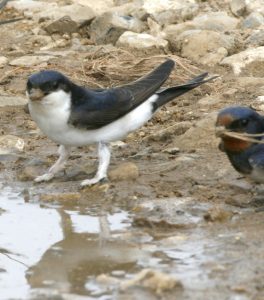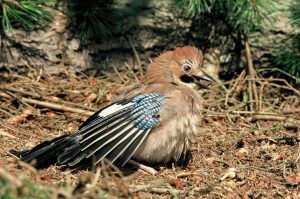House Martin Migration 2018 & Helping Them Nest
House Martin Migration
House Martins normally arrive back on our shores from sub-Saharan Africa during April, though some years these small, acrobatic white-rumped birds will start to appear at the end of March. This year though, the main migration was rather later with many birds not arriving until early or even mid-May. More worryingly still, the number of returning birds seems to be lower – which continues a trend of decline, with a study carried out between 2001 and 2011 showing a 16% drop in numbers.
[caption id="attachment_1545" align="alignleft" width="264"]
 House martin collecting mud for its nest (swallow to its right)[/caption]
House martin collecting mud for its nest (swallow to its right)[/caption]The reason for the late arrival of House Martins and other migrants including Swallows and most species of Warbler is thought to be weather-related and specifically storms in France and an unseasonal northerly wind which the birds had to battle against.
Reasons for the decline in numbers of House Martins are more complex and not yet fully understood, though a reduction in flying insects due to modern farming methods is almost certainly a factor.
Anyway, the House Martins that are back with us for the summer can now do with all the help they can get to ensure a successful breeding season.
You might think that as we’re already in early June there’s not much you can do to help with their nesting, but actually, it’s not too late in the breeding season to give House Martins a helping hand! House Martins often wait for around four weeks before looking for the right nest site and starting to build.
So, what can you do to help House Martins?
There are two main things . . .
- Putting up one or two of our House Martin nest boxes in a suitable place under the eaves of your property will not only provide an instant nest site but may well encourage other House Martins to build their own nests right alongside the artificial ones. House Martins tend to favour north and east facing sites, meaning the nest is out of strong midday sunshine, so this will also be the best option for your nest boxes. If the birds don’t use the nest boxes this year, then they’ll be ready and waiting for them when they return next spring.
- When House Martins build their own nests, they’re entirely dependent on a supply of wet mud – which they’d naturally get from river banks and edges of puddles, for example. However, depending on where you live and also if you’ve missed the recent thunderstorms, then wet mud close by to a suitable nest site might actually be difficult for House Martins to find. So the answer is to make some available, which can be mixed in a shallow tray and then left in the middle of the lawn. The best type of mud is clay-based – but don’t worry too much if that’s not the type you have in your garden. It may take a pair of House Martins up to three weeks to complete the nest, so keep plenty of mud available, if possible.
So it’s not too late to help House Martins out this breeding season if you get cracking now.


